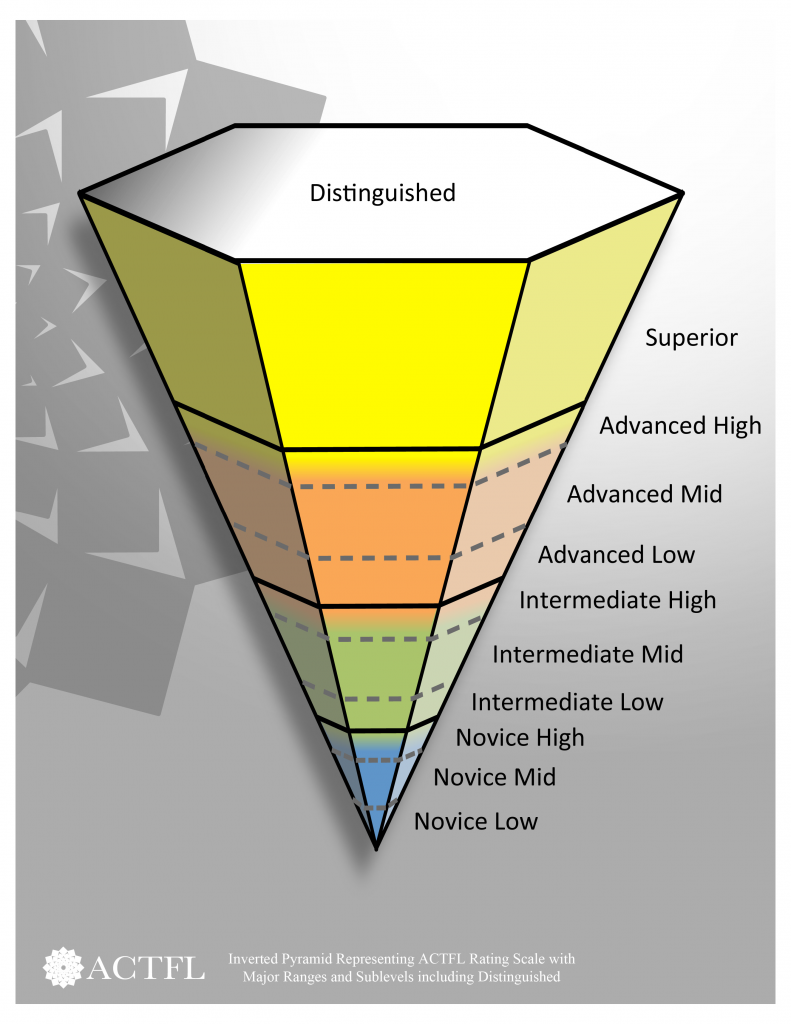The American Council on the Teaching of Foreign Languages (ACTFL) Proficiency Guidelines provide language educators with valuable parameters for assessing a learner’s skills in particular areas. These guidelines are important for evaluating how students use their language skills in real-world situations, building toward true proficiency in the target language.
ACTFL organizes proficiency levels into the areas of speaking, writing, listening, and reading. Each skill has a proficiency range: Distinguished, Superior, Advanced, Intermediate, and Novice. The three main proficiency levels of Advanced, Intermediate, and Novice each have sublevels of High, Mid, and Low. Levels are cumulative, so a language learner should be able to perform all Novice skills, for example, before being considered Intermediate in a certain skill.

For the purpose of this blog post, we have summarized major characteristics in each skill at the Novice, Intermediate, and Advanced levels. We hope that language educators will find this overview helpful as they determine their students’ proficiency. For much more detail about language proficiency and performance, check out these resources:
- ACTFL Proficiency Guidelines 2012
- Measuring Success in Dual Language Programs
- Understanding the ACTFL Assessment of Performance Toward Proficiency in Languages (AAPPL)
Speaking skills:
- Novice:
Novice speakers are able to use basic words and memorized phrases about everyday topics. Learners can maintain simple conversation but cannot yet speak in sentence-level discourse. - Intermediate:
Intermediate speakers use learned vocabulary and material to create personal meaning with the language. They are able to speak in short sentences or strings of sentences about everyday topics. - Advanced:
Advanced speakers are able to produce a paragraph or multiple paragraphs of speech on a variety of topics, both formal and informal. Speakers are able to communicate in time frames of past, present, and future.
Writing skills:
- Novice:
Novice writers can reproduce practiced words and simple phrases. As learners progress to Novice High, they can create short, simple sentences with familiar vocabulary but cannot sustain sentence-level writing all the time. - Intermediate:
Intermediate writers can communicate simple, practical information and write answers to basic questions. Learners mostly use present tense in their writing, but may begin to use different time frames as they progress. - Advanced:
Advanced writers can meet basic work and/or academic needs with their writing. They can write paragraphs, linking sentences and ideas together. Learners are able to use major time frames and generally be understood by native speakers not used to the writing of non-native speakers.
Listening skills:
- Novice:
Novice listeners understand high-frequency words or phrases in predictable, highly contextualized situations, such as greetings or basic courtesies. Listeners at this level typically require repetition, rephrasing, and slowed speech to help with comprehension.
- Intermediate:
Intermediate listeners understand simple, sentence-length speech in which the context is mostly familiar and predictable. These learners need a controlled environment where they hear what they expect to hear. - Advanced:
Advanced listeners can comprehend narrative and descriptive texts that have a simple underlying structure. As learners progress to the Advanced High sublevel, they are often able to recognize a speaker’s intended inferences.
Reading skills:
- Novice:
Novice-level readers are able to recognize words and phrases when they are presented in context and are highly predictable, such as on receipts or in weather maps. Novice readers rely on images and predictable, formulaic words and phrases. Learners are best able to understand when they can anticipate the information within the text. - Intermediate:
Intermediate readers can understand simple, predictable texts that use high-frequency vocabulary. Readers can understand loosely connected texts, but may sometimes miss information if a text is more detailed or uses unfamiliar vocabulary. - Advanced:
Advanced readers can understand the main idea and supporting details of texts with a clear underlying structure. As readers progress from Advanced Low to Advanced High, comprehension of the text comes from knowledge of the language itself, not just context or subject matter knowledge.
For materials on how you can help language learners build their proficiency, see Participate Learning’s resources for teachers.
Participate Learning provides professional development for language educators and aids schools and districts in evaluating their dual language programs. Explore our Dual Language Mastery Program to see how we support educators and ensure success for both teachers and students.




